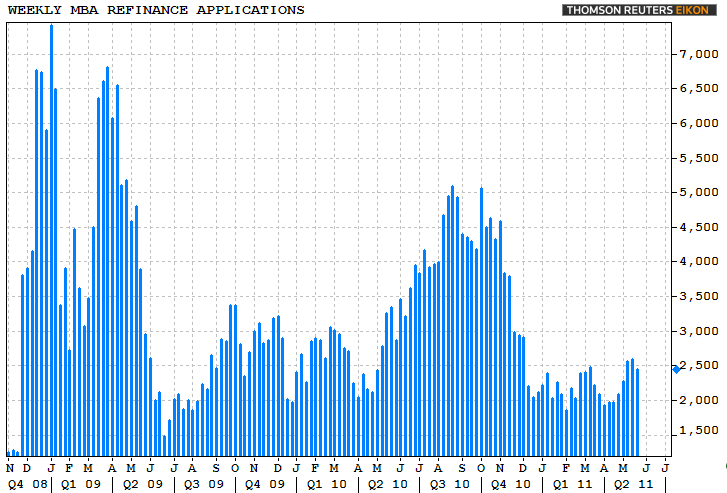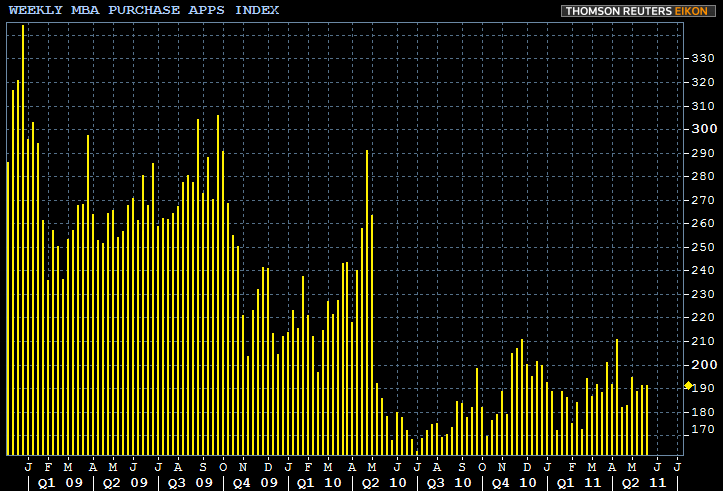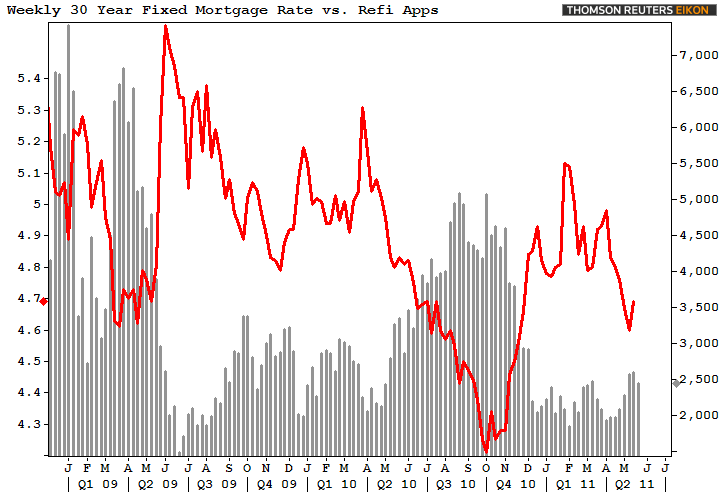Blog

Refinance Demand Plagued by Tight Credit & Falling Home Prices
The Mortgage Bankers Association (MBA) today released its Weekly Mortgage Applications Survey for the week ending May 27, 2011.
The MBA’s loan application survey covers over 50% of all U.S. residential mortgage loan applications taken by mortgage bankers, commercial banks, and thrifts. The data gives economists a snapshot view of consumer demand for mortgage loans. In a falling mortgage rate environment, a trend of increasing refinance applications implies consumers are seeking out lower monthly payments. If consumers are able to reduce their monthly mortgage payment and increase disposable income through refinancing, it can be a positive for the economy as a whole (may boost consumer spending. It also allows debtors to pay down personal liabilities faster. A trend of declining purchase applications implies home buyer demand is shrinking.
Excerpts from the Release… </p
The Market Composite Index, a measure of mortgage loan application volume, decreased 4.0 percent on a seasonally adjusted basis from one week earlier. On an unadjusted basis, the Index decreased 4.2 percent compared with the previous week. The four week moving average for the seasonally adjusted Market Index is up 3.0 percent. </p
The Refinance Index decreased 5.7 percent from the previous week. The four week moving average is up up 3.8 percent for the Refinance Index. The refinance share of mortgage activity decreased to 65.7 percent of total applications from 66.8 percent the previous week.</p
 </p
</p
The seasonally adjusted Purchase Index was essentially unchanged from one week earlier. The unadjusted Purchase Index decreased 1.2 percent compared with the previous week and was 7.6 percent higher than the same week one year ago. The four week moving average is up 1.1 percent for the seasonally adjusted Purchase Index.</p
 </p
</p
The 30-year rate is the lowest since November 2010. The average contract interest rate for 30-year fixed-rate mortgages decreased to 4.58 percent from 4.69 percent, with points increasing to 1.01 from 0.69 (including the origination fee) for 80 percent loan-to-value (LTV) ratio loans. </p
The average contract interest rate for 15-year fixed-rate mortgages remained unchanged at 3.78 percent, with points increasing to 1.07 from 1.04 (including the origination fee) for 80 percent LTV loans. The effective rate also increased from last week.</p
The adjustable-rate mortgage (ARM) share of activity increased to 6.2 percent from 5.8 percent of total applications from the previous week.</p
 </p
</p
“Interest rates fell last week as incoming economic data was weaker than anticipated. Despite this drop in rates, the number of refinance applications fell. In fact, the last time mortgage rates were this low, refinance volume was more than twenty percent higher. It is likely that many borrowers still cannot qualify to refinance given the lack of equity in their homes,” said Mike Fratantoni, MBA’s Vice President of Research and Economics.</p
From last week’s MBA Apps recap : Loan Demand Lags Interest Rate Rally. Several Reasons Cited</p
Rates are at 6-month lows but loan demand hasn’t increased as much as one might have anticipated. Last week we wrote,rn “Right now we’re witnessing the beginnings of a mini-refinance boom in the primary mortgage market, but there has been little activity in the secondary market that would indicate increased rate locking by consumers.” says MND’s Managing Editor Adam Quinones. “However, if conventional 30-year rates reach 4.25%, we’d expect to see a mini-boom scenario play out. There is much stored demand in the system as many qualified borrowers missed the boat on record low rates in October and early November. This crowd is waiting in the wings for those rates to return. Whether or not that happens is still very much up in the air” </p
In reaction to that comment, Ted Rood,rn a loan originator from MetLife Home Loans added, “One thing to considerrn regarding refi volume is that HUD effectively ended FHA streamlines over the course of the last year by tightening underwriting guidelines and jacking up monthly MIP fees. After the change, many existing FHA clients have been unable to meet net benefit rules, even when dropping their rate by 1% or more, since their monthly MIP would double on the new loan. So FHA clients don’t get to benefit from lower rates and HUD doesn’t get new upfront MIPs from existing clients with clean payment histories who want to refinance”.</p
READ MORE: New FHA MIP Structure to Slow Streamlines</p
READ MORE: Rents Seen Rising as Poor Credit Hurts Homeownership Demand</p
READ MORE: Realtors Request Looser Credit Regs as Home Sales Decline</p
READ MORE: Case-Shiller Data Confirms Double-Dip in Home Prices</p
All Content Copyright © 2003 – 2009 Brown House Media, Inc. All Rights Reserved.nReproduction in any form without permission of MortgageNewsDaily.com is prohibited.
Latest Articles
By John Gittelsohn August 24, 2020, 4:00 AM PDT Some of the largest real estate investors are walking away from Read More...
Late-Stage Delinquencies are SurgingAug 21 2020, 11:59AM Like the report from Black Knight earlier today, the second quarter National Delinquency Survey from the Read More...
Published by the Federal Reserve Bank of San FranciscoIt was recently published by the Federal Reserve Bank of San Francisco, which is about as official as you can Read More...

Comments
Leave a Comment